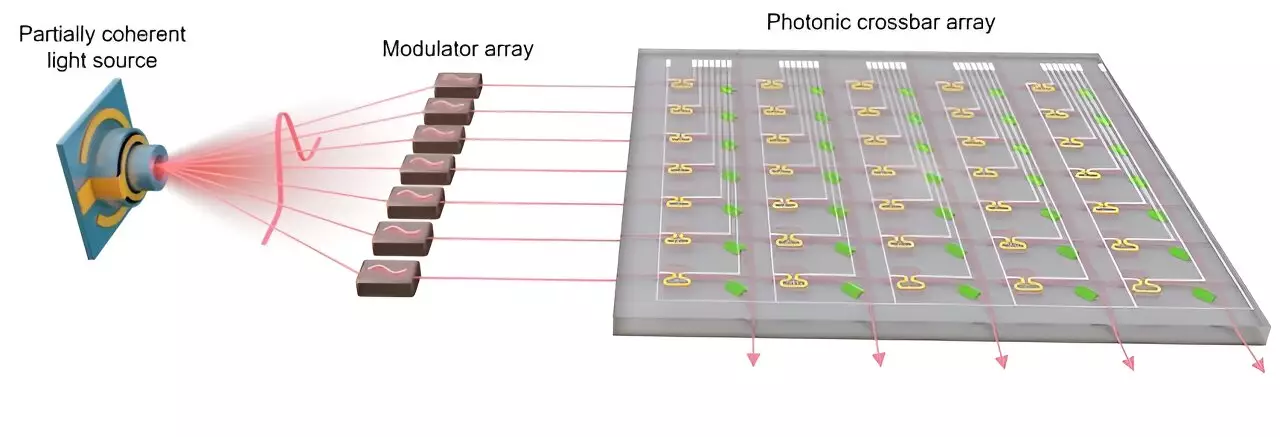Recent advancements in photonic computing present us with a groundbreaking revelation that challenges long-standing assumptions in the field. Traditional thinking has suggested that light sources emitting coherent waves—such as high-quality lasers—were essential for maximizing system performance in optical applications. However, an innovative study published in *Nature* by researchers from the University of Oxford, in collaboration with institutions in Muenster, Heidelberg, and Ghent, unveils that partially coherent light sources can deliver unexpected advantages over their highly coherent counterparts. This radical shift not only undermines previous beliefs but also heralds new opportunities for reducing costs and energy consumption in technologies crucial to the evolving landscape of artificial intelligence.
The Complexity and Cost of Light Sources
Historically, the pursuit of the most sophisticated light sources has been primarily driven by the need for precision and uniformity, evident in various applications from optical communication to medical imaging. Coherent light sources, characterized by their uniform wavelengths and phase relationships, have established themselves as indispensable tools for high-resolution tasks. However, the reliance on intricate and costly laser systems raises questions about accessibility and scalability. As technology advances, the industry requires more adaptable and economical solutions, primarily as we navigate the integration of AI in broader applications. This is where the findings of the Oxford team reshape the dialogue surrounding optical technologies.
Harnessing the Power of Incoherent Light
The pivotal focus of the research centers on the potential of using partially coherent light, which encompasses a broader wavelength spectrum and often resembles the output from widely accessible light sources, such as incandescent bulbs and sunlight. In particular, the team utilized an electrically-pumped erbium-doped fiber amplifier to harness narrow bands of incoherent light. They discovered that distributing this partially coherent light across multiple input channels not only facilitated parallel processing but significantly accelerated computations in a photonic AI accelerator designed to emulate neural processing.
Transforming AI Computation
The results are compelling: utilizing this innovative light generation strategy enables a remarkable enhancement of computational capabilities in photonic systems. By applying this approach, the researchers achieved an impressive 92% accuracy rate in classifying Parkinson’s disease patients based on walking analysis. Moreover, the system’s capacity to perform high-speed AI operations at a staggering 100 billion calculations per second stands as a testament to the potential efficiencies unlocked by this methodology. Such capabilities provide a stark contrast to existing laser-based photonic accelerators, which often rely on multiple, complex laser systems to attain similar performance metrics.
Scalability and Future Applications
The implications of this breakthrough extend beyond the realm of AI. As noted by lead researcher Dr. Bowei Dong, utilizing less complex light sources can offer a scaling effect, paving the way for accelerated AI models that might dwarf the capabilities of traditional laser systems. This revelation carries profound implications for the future of photonic computing, particularly as we explore further applications in optical communication and interconnect technology. By prioritizing simplicity and efficiency over complexity, researchers could redefine paradigms across sectors reliant on light-based computational systems.
Redefining the Future of Technology
The study exemplifies how rethinking existing methodologies can lead to revolutionary outcomes. Instead of adhering to the notion that the highest-performing technologies need to be the most sophisticated, there is merit in exploring alternative avenues that prioritize accessibility and efficiency. The potential to harness partially coherent light as a viable substitute for lasers not only democratizes access to advanced photonic technologies but could also spur innovation across an array of fields. As further investigations delve into the myriad of applications for this type of light source, it is clear that we are merely scratching the surface of its capabilities.
The future beckons a landscape where the reliance on expensive, high-maintenance equipment may diminish, and more versatile, cost-effective solutions prevail. The findings from Oxford’s interdisciplinary research serve as a harbinger for the next frontier of photonic applications, paving the way for transformative advancements that were once considered unattainable. As the world increasingly integrates AI and photonic systems into daily life, these discoveries not only signify a leap forward in technology but also a promise of a more sustainable and accessible future.

